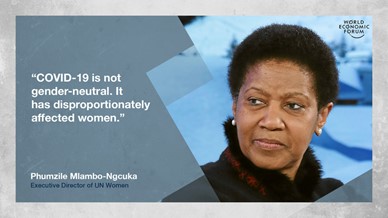As part of our series of blogs examining the twelve critical areas for gender equality presented twenty-five years ago in the Beijing Platform for Action, SI UN Representative in Geneva, Berthe De Vos, considers the topic of Women in Leadership.
“Although, many people think that inequality between men and women in our society is a thing of the past, conclusions from the 25-year review of Beijing Plan of Action indicate that we are far from realising the promises made in 1995. The world has to realise we are not yet there, and that gender inequality still very much exists in both the public and private arena.
Looking into women’s participation in political and public life – women are able to vote and to be elected for more than 100 years, and although there has been much discussion of increasing the numbers of women in political and administrative leadership positions, there has not been much change. Today, it is becoming more common to see women in leading positions, however, the number of female leaders around the globe is still very limited.
The World Ranking of the Inter-Parliamentary Union (IPU) each year ranks the number of women in national politics. Results in October 2020 show that only 14 of the 193 United Nations (UN) members have a woman in the highest position of executive power, which is less than 10% of the men in power. Currently 24.9% of women are elected in parliaments, which is more than double that of 1995 (11.3%). In recent years, Rwanda is still the striking leader of this change. Its national parliament consists of more than 60% women. Other countries who have been at the top are Cuba, Bolivia, and the United Arab Emirates with a participation of 50%.
Currently, 19 out of the more than 300 world leaders and Prime Ministers are women. Within the European Union (EU), there are currently five heads of state and three female Prime Ministers. Outside of the EU, we currently find just five female world leaders. Elsewhere, there are two female world leaders in the Caribbean, five in Asia, two in Oceania, two in Africa, one in Central Asia, and currently none in South America or North America.
Also, in a recent study on power and decision-making, McKinsey shows that today more women are being elected: this year 25.2% of parliamentary lower-house seats and 21.2% of ministerial positions are held by women, compared to 24.1% and 19% respectively last year.
Historically, we learn that society has a biased view on leadership and tints it with masculine glasses. Despite the progress that the feminist movement has made, misogyny still exists, and the world (men and women) still favours men at the expense of women for leading roles. Furthermore, there are people in leadership positions who actively stand against women in power, a striking sign that misogyny is still present in our society, especially outside Europe/United States. Education is also not playing a positive role. Too often female students are pushed into more ‘traditional gender stereotypes’ as opposed to treating both genders equally (whether directly or indirectly through gender bias).
Women in leadership positions remains a sensitive issue on the agenda. Society is talking about it and the realisation they could benefit from more female leadership seems to be growing, but global statistics at the same time show that little or nothing is changing. At the highest level, the power remains very traditionally in the hands of white, middle-aged men, whilst demographic developments take a different direction. A clear role model on female leadership is needed and this will be the challenge for organisations now. Women are dynamic leaders of change and their participation is fundamental to democratic governance. Only recently, people began to realise that gender diversity at all levels brings great advantages. Over the past decades, researchers have conducted several studies to learn more about the relationship between women’s discrimination and leadership. In particular, whether these differences were the cause of the limited number of women in power.
It is important for society to understand that once women are in leadership roles, they can make a difference that can be felt beyond their direct influence: society as a whole. Women politicians have a different approach to leadership. By giving more attention to social welfare and legal protections, they will improve trust, yield the economy and add equal value alongside their male counterparts.
Women have the right to equal participation in the society. ‘Gender’ isn’t supposed to be a reason for whether or not a person can be a remarkable leader. A person’s leadership abilities should depend on their individual strengths and personality traits.
The existing stereotypes and the associated expectations about men and women are principal causes of the relatively low percentage of women in politics, but perhaps not always… Often, we see a man as a successful leader, which means that women are sometimes overlooked for functions that demand these ‘masculine’ characteristics. Not helping the case is the fact that less female leaders exist to stimulate young female adolescent into political interests. Furthermore, women may consider themselves less suitable; women more often need a little push to enter politics and must more often only say ‘yes’ when asked to enter the political arena.
Different studies propose different solutions to support women get more involved in leadership. The simplest way to get more women into politics is to make electoral lists with equal participation and to lobby women to vote for the women. We see that if this happens, women receive preferential votes more often than men. But this is not enough to get a fair distribution. A vote for a woman initiative calls on the voter to choose a woman who may not be elected.
Other options are to tackle the education system in order to motivate women from a young age to strive for leading positions and demanding quotas on the electoral lists. Demanding quotas, running actions, creating trainings and campaigns, who specifically target women could perhaps change the outcome and change a prejudice for the long run.
It is important to realise that gender inequality lives and breathes in the 21s t Century, through strong direct and indirect barriers. To get more women into politics, we have to break the cultural biases against women and stereotypes; a change in mentality is necessary. Sexism and attention on the appearance of female politicians is a deterrent. There are some ways we can help drive this change, such as by improving our own awareness and prejudice, to allow us to critically observe these differences on a social, cultural, and educational level. The final step is an active promotion in driving equal opportunities to achieve leadership status. Society should not ask themselves whether women are ready for a key position, but whether they are ready to give women their vote of confidence. Perhaps this pandemic will help to turn around the stigma.

The words of Phumzile Mlambo-Ngcuka, executive Director of UN Women states it all: “We need men and women leading the recovery, 85% of nurses on the frontlines are women, but women are not part of leadership groups in this crisis. For every three people who present public statements about COVID, only one is a woman. And so then we are seeing the challenge of women being under-represented in leadership roles, even in sectors where they are well represented generally. In the health sectors where women are already the majority, we don’t have a pipeline [to leadership positions]. Women must be included – there’s no reason why men should be at the forefront. We need men and women leading the recovery, in order to make sure that the issues that affect women and the issues that are affect men are equally addressed.”
So, let us end with a better gender balance in politics as a means to better society as a whole. Let’s hold hands and see how far we can get!”
Further information:
https://www.mckinsey.com/featured-insights/diversity-and-inclusion/women-in-the-workplace
https://beijing20.unwomen.org/en/in-focus/decision-making
https://www.catalyst.org/research/women-in-sp-500-companies/
https://www.weforum.org/agenda/2020/10/phumzile-mlambo-ngcuka-un-women-jobs-reset/
https://www.tandfonline.com/doi/abs/10.1080/01402382.2017.1320082
https://www.ipu.org/resources/publications/infographics/2020-03/women-in-politics-2020
For access to more blogs from this series Visit: https://www.soroptimistinternational.org/tag/beijing25/


Up Nation Wide the Women To Get Up than sixty % women In Leadership!
I think you did a great job explaining how the world hasn’t changed much based on gender inequality. From my point of view, many women still are being disrespected and attacked every single day. I believe we must start changing the way we educate our children to how we treat other women in our lives, so I’ll spread the word about it. Thanks for the insight on how inequality exists in our modern world. https://awomansrighttochoiceletter.com/